The following is a contributed piece by guest writer, Katie Losey.
Banning swimsuits suggests they are X-rated and risqué, but that’s not why speedos made waves at the 2008 Beijing Olympics. That year, 98% of the Olympic medals were won by swimmers wearing full-coverage swimsuits modeled after sharkskin. Swimmers without these special speedos didn’t stand a fair chance. The breakthrough innovation was too good. The “technology doping” suits were banned.
The secret sauce? An R&D lab that’s 3.8 billion years old converging with human ingenuity.
There’s more: Bulletproof vests more indestructible than Kevlar® were inspired by spider silk; the world’s most in-demand, advanced robotic arms were inspired by elephant trunks; and most don’t realize Japan’s game-changing bullet train was redesigned to be less like a bullet and more like a kingfisher bird beak for superior efficiency, speed, and noise reduction. Even slime mold, an organism without a brain or nervous system, stunned the world when it took 26 hours to map out Tokyo’s train system—a complex network that took human ingenuity over 100 years to figure out.
Innovation so good that the status quo doesn’t stand a fair chance is what the world needs right now, and today’s game changers have one thing in common: nature’s lab. Leaders like NASA, the US Naval Academy, Nike, and Bill Gates are paying attention. These are not some hoped-for miracle technologies. Proof of concept exist, give us bold answers to our greatest problems and show us new ways in which humanity could thrive. We just need to pay attention and connect the dots.
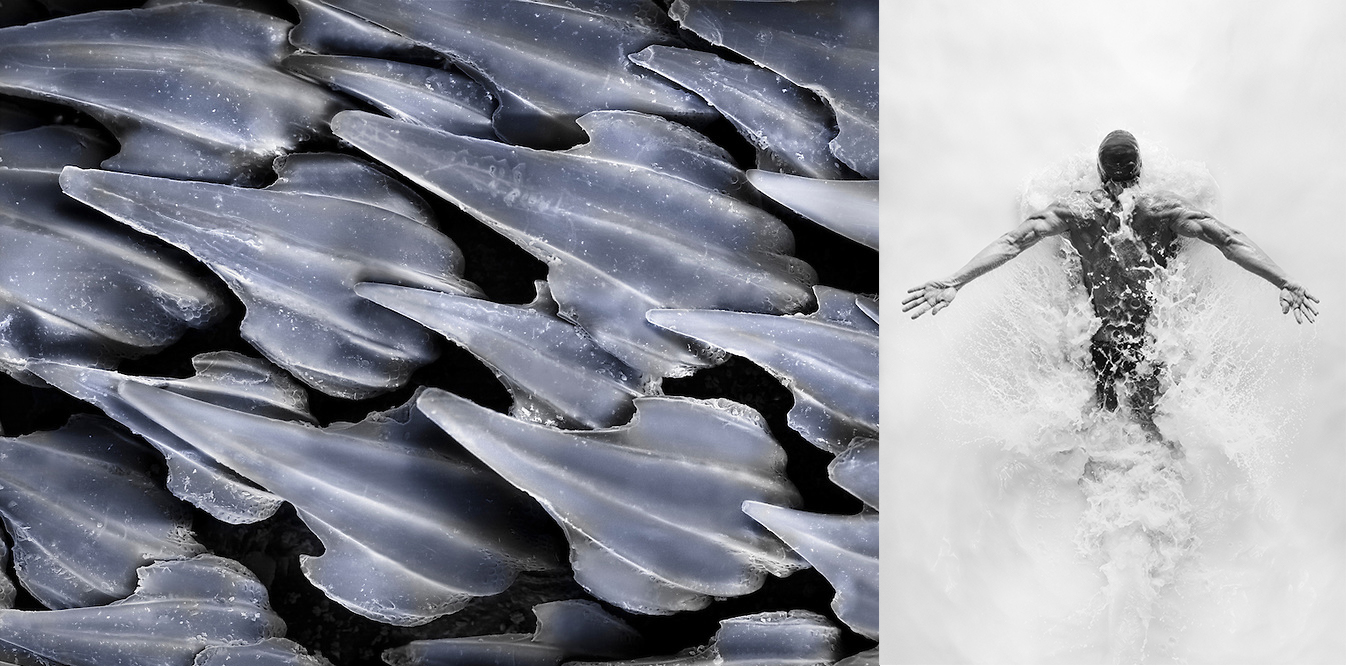
At the 2008 Beijing Olympics, 98% of the Olympic medals won were by swimmers wearing full-coverage swimsuits modeled after sharkskin. Above left: shark skin’s dermal denticles under a microscope © Alex Hyde | Above right: photograph by Carlos Serrao.
How a slug revealed the greatest innovators of our time
A chubby slug gets credit for waking me up to this fascinating field. I bet you’re not a fan of these slime balls, but I’ll also bet you would be impressed by the innovations these tiny trailblazers have inspired. Rewind to a few hot summers ago, when I was unsuccessfully scrubbing slug slime from my leg, and I bet my 8-year-old niece, Atlee, that one day this stubborn stuff would inspire an invention. Hours later we heard just that: NPR spotlighting a breakthrough human-made superglue to help mend beating hearts—inspired by slugs.
If a slug can help heal a beating heart, we have to believe that between the forest and ocean floor hides unthinkable solutions to so much more. Below, eight inventions from nature’s laboratory showing the future of innovation is transforming the way we live and survive on this planet:
Innovation: Life-saving surgical superglue
Problem Solved: Revolutionizing the way surgical wounds are closed
Nature’s Solution: Slug slime
Market Readiness: Lab
Slugs rank low for many of us, but they are a potential godsend for surgical teams and are the inspiration behind a new biomedical adhesive that could possibly save your life.
Some organs in our bodies, like hearts and lungs, are a challenge to repair (ie delicately patching a hole in a beating heart or repairing cartilage) because they are wet, and moving. Typical surgical adhesives and tapes are not sticky or flexible enough to work on the wet tissue.
Now engineers are looking to mimic slug mucus because it has the sticking power of superglue, it’s highly stretchable, biocompatible (our bodies don’t reject it), stretchy as a rubber band and so sticky it can reconnect wet pieces of heart or lungs back together. Plus it’s made without toxic, harsh chemicals, and eventually it’s possible this “glue” could disintegrate safely back into the body.
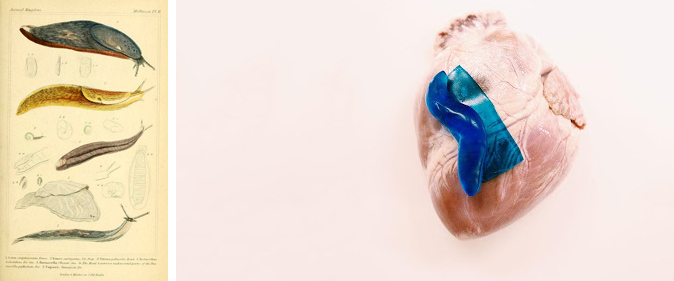
Seemingly lowly slug mucus has inspired researchers to create a new potentially life-saving superglue to mend beating hearts | Above left: Gastropod prints from the Biodiversity Heritage Library | Above right: source NPR
Innovation: Wind turbines
Problem solved: Making more efficient, quieter, and greener turbine aerodynamics
Nature’s Solution: Humpback whale
Market Readiness: Commercially available
Although it may seem counterintuitive, the bumpy ridges on the leading edge of humpback whale flippers actually help them increase lift and reduce drag at the same time. After adding this saw-like design to wind turbines, wind farms use 25% less energy to produce 20% more power.
This design shift was a surprise to many engineers, who believed that a smooth leading edge would result in superior efficiency. But experts determined that with bumpy fins, humpbacks can have a steeper angle of attack (the angle between the flow of water and the bumpy edge of the flipper), helping the whale to move effectively. This can be witnessed during their unique “bubble net feeding behavior” when they maneuver in tight circles and herd krill using air bubble clouds that entrap their prey.
Making adjustments like this to wind turbine design can be meaningful as we work towards investing in cleaner, renewable energy to cut greenhouse gas emissions at a scale that could make meaningful changes to our country and the planet.
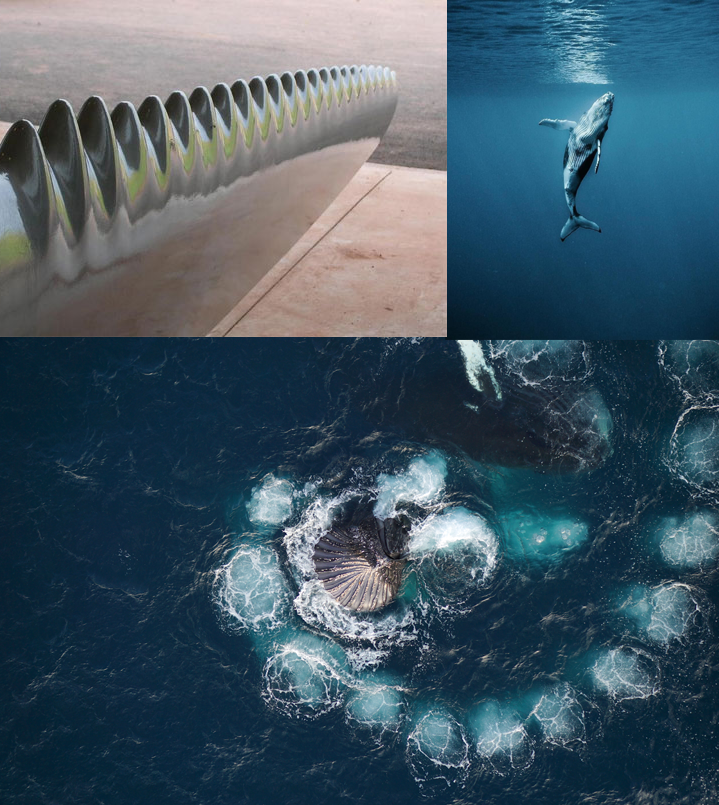
After emulating the bumpy ridges of a humpback whale fin during wind turbine design, wind farms use 25% less energy to produce 20% more power. Above left: WhalePower turbine | Above right: bumpy ridges on a humpback whale fin (photo Ain Raadik); Bottom: the humpback’s fin ridges help them maneuver in tight circles entrapping food like krill; photo by Duke Marine Laboratory
Innovation: Efficient, elegant aircraft
Problem Solved: Transport that’s faster, quieter and goes further
Nature’s Solution: Manta ray
Market Readiness: Lab demo/Early commercial
We have historically looked up for flight inspiration: Leonardo da Vinci’s flying machine sketches were inspired by birds and bats, pigeons inspired the Wright Brothers’ first successful airplane, and the military’s mini drones emulate dragonflies. But there’s a new kid on the block (or runway): manta rays.
Manta rays dance through the water, at times leaping into thin air for no reason at all other than perhaps the pure thrill of it. Now, their graceful ways are literally taking to the skies, giving us a new lens on flight. They continue capturing our attention in new ways as designers flirt with an innovative aircraft that could go faster, quieter and more efficiently. With more than 50,000 planes expected to be flying in the next two decades, skyrocketing efficiency will be essential to our decarbonization goals.
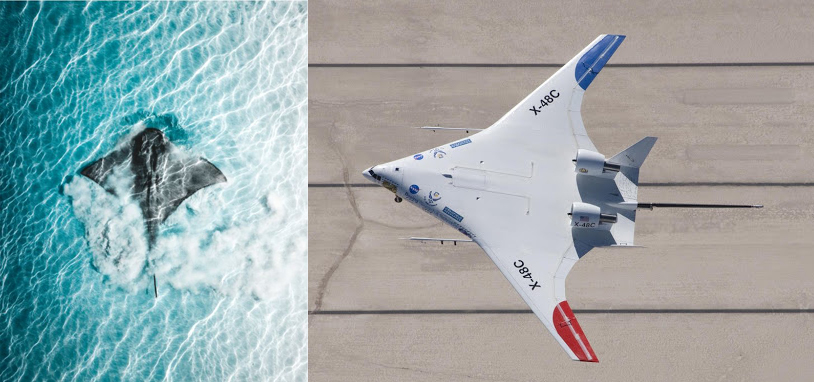
Manta rays gracefully glide through the water, giving NASA and Boeing engineers new inspiration for an aircraft like this X-48C that’s more efficient and quieter helping them reach environmental goals | Above left image by Phil de Glanville | PHLY Images; above right photo: NASA / Carla Thomas
The sleek, aerodynamic design has caught the attention of NASA engineers and Boeing who looked at the manta ray wing when designing various versions of the aircraft known as X-48. The single body unit has an innovative blended wing body structure, where the engine of the aircraft sits on the plane wings versus under them and a lack of a conventional tail. This aircraft has demonstrated NASA’s goals of reduced fuel, emissions and noise, though one of the bigger challenges is the lack of a conventional tail has made it more challenging to stabilize and control.
And this year, Lilium has people talking about their Lilium Jet, an all-electric air taxi which mimics manta rays’ structure: minimal, elegant, wings, no tail, no rudder, and only one moving part in each engine. The winner of the prestigious Red Dot Award, this five-seater aircraft takes off and lands vertically and could be another path towards decarbonization as early as 2025.

The all-electric air taxi from Lilium Jet also takes its design inspiration from the manta ray: minimal, elegant, and efficient. Above photos: Lilium.
Innovation: Artificial Photosynthesis: A bionic leaf that creates hydrogen fuel from sunlight
Problem solved: Clean our air + end fossil fuel addiction
Nature’s Solution: Leaves + Photosynthesis
Market Readiness: Lab/development
What if you could power the world with the air we breathe, sunshine and water? It’s possible.
The ingenuity behind this potential global energy breakthrough is the common leaf. By emulating its process of photosynthesis (a leaf’s way of converting sunshine, carbon dioxide, and water → oxygen and energy) we can generate our own clean, hydrogen fuel, just by splitting water using electricity from the sun. Read: this renewable fuel has no emissions. Zero. The byproduct, water, is so clean you could probably drink it out of your tailpipe.
If you think about it, that laptop on your desk, it’s powered by photosynthesis. Fossils fuels are the remains of plants and animals, all of which grew up with sunshine, and we burn those fossils for new energy, which means that everything we consume—from the apple in your hand to the Apple laptop on your desk—is actually a product of photosynthesis.

What if we can beat nature at its own game? Emulating the humble leaf means we could forgo gas stations and generate our own clean, hydrogen fuels straight from sunlight, air and water. At the time of writing, artificial leaves are close to 10% efficiency compared to 1% efficiency of leaves in nature | Photograph by Katie Losey
With Harvard professor Daniel Nocera, Caltech’s Nate Lewis and engineers at the University of Chicago and the University of Michigan at the helm, scientists are working towards hacking photosynthesis in an efficient way so that they can essentially put this bionic leaf in water, shine sunlight on it, and then observe as hydrogen and oxygen are released. But they don’t just want to copy nature—they want to beat nature at its own game and accelerate the process. While the common leaf’s photosynthesis process converts about 1% of the energy from sunshine, the bionic leaf is inching beyond 10% efficiency.

Are hydrogen-fueled cars already approaching their breakthrough moment? Some would say that hydrogen has the potential to lead to energy security, improved air quality with zero emissions. Their greatest challenge today is lack of infrastructure and cost to make and transport. Government and global investment will be vital in scaling this potential climate solution. Above image | NISSAN
The commercial artificial leaf is not available yet. Right now the production of solar fuels cannot compete economically with fossil fuels, but researchers are working hard to change that, and the bionic leaf is approaching the stage of commercialization.
Innovation: Greenhouses in the desert
Problem Solved: Reversing desertification
Nature’s Solution: Camel nostrils & Namibian fog-basking beetle
Market Readiness: Commercial
Camel nostrils are damn hard to beat as an atypical source of design inspiration. But these two flaring beauty marks are part of the ingenuity behind turning an infertile desert on the outskirts of a Jordan airport into a fertile greenhouse. As if nostrils weren’t clever enough, they also turned to the Namibian fog-basking beetle for its brilliant adaptation to find fresh water in one of the most inhospitable places on Earth.
Camel nostrils?
The architectural team looked at the nose of a camel, and how during the cooler evenings, the surfaces of its nostrils cooled exhaled air during the evenings, and then they extract water vapor from the exhaled air. (On the other hand during hot desert days, camels exhale air that’s hot and saturated with water vapor in order to prevent their brains from overheating versus the goal of conserving water.)
Namibian beetles?
They also emulated how the Namibian fog-basking beetles harvest fresh water from the driest deserts on Earth. At night, the beetle climbs to the top of a sand dune, and his dark, black shell naturally radiates heat into the desert sky, slightly cooling it down from the rest of the area. While he rests atop sand dunes and winds blow inland from the sea, tiny drops of water vapor or morning fog form on the beetles’ shell. The bumps on their bodies (known as hydrophobic troughs or bumps) help gather the water. He then tips his body, and drinks in the water before the sun rises.

Power couple: The Namibian fog-basking beetle and camel nostrils have helped inspire the Sahara Desert Project which has turned a barren plot of desert land into a green oasis | Beetle photograph above by Solvin Zankl Photography; illustration of the Jordan launch project by The Sahara Forest Project
These were two symbiotic and proven in nature techniques were the quirky inspiration when creating the saltwater-cooled greenhouses that will use the same mechanism of harnessing the difference in temperature between surface seawater and seawater from below the surface. They chose the least green places on the planet for The Sahara Forest Project: the pilot was in Qatar and the launch station in Jordan is the size of four football fields. While both lack access to fresh water, they harness two abundant resources: sunshine and saltwater—virtually all they needed to make this a success due to mimicking the camel and beetles’ adaptations.
At the time of writing, the precious bounty produced using solar power and saltwater in the desert from the greenhouse will help feed travelers making their way through Jordan. Camel nostrils and humble beetles have inspired new ways to feed the world in places facing desertification.
Innovation: Prosthetics & factory robots
Problem Solved: Limited prosthetics & robots; unintuitive human-technology interaction
Nature’s Solution: Elephant trunk
Market Readiness: Commercial
Many humans are enchanted by elephants because as wild as it seems, they are a lot like us. These charismatic icons are self-aware, wise, and emotional creatures but bioengineers are captivated by them for another reason: their trunks. This organ is the genius behind some of the most in-demand artificial limbs and robots that exist today.
Ever since I watched an elephant trunk go from snorkel to tree leveler in a matter of seconds, I understand why. While our arms and hands have bones and joints, elephant trunks have neither. They have something arguably better: 40,000 muscles for incredible flexibility. Their tremendous range of motion and eleven degrees of freedom for movement enables them to go from uprooting 400-pound trees to delicately plucking a blade of grass. Human limbs don’t come close to this level of capability! An elephant trunk remains their most versatile tool used for communicating, smelling, breathing, even protecting their young.
Engineers have created a robotic limb made using 3D-laser sintering that mimics the features that make the trunk so extraordinary including flexibility, precision, control and efficient movement. Plus, it’s made without any iron or steel for a safer design that moves more naturally and lightweight (some are only five pounds).
Elephant trunks are also revolutionizing robot factory productivity, unleashing major opportunities for industrial applications spanning agriculture, domestic household work and the automated handling industry. The high-functioning and intuitive artificial limbs have shown major progress in the marriage of machines and human interaction. One day, these machines could be 3D printed and print entire buildings.

Modeled after an elephant trunk, Festo’s bionic handling assistant has revolutionized handling technology.
Innovation: Self-cooling buildings
Problem Solved: Decarbonize, cut costs and reduce dangerous greenhouse gases
Nature’s Solution: Termite mounds
Market Readiness: Commercially Available
In one of the last places you’d think to look, the world’s top architects have found answers to electricity-free air conditioning. Their inspiration? Termites.
My first clue that termites had figured out something we haven’t was on safari in Kenya. Termite mounds can be a forgettable part of the experience when lions and leopards are within site, but our guide shared there’s something remarkable going on inside the termite temples: termites created nature’s answer to air conditioning. With an intricate system of vents throughout their mud temples, where solar-driven air currents flow from above-ground mounds to below-ground ones, they’ve figured out a design solution we hadn’t.
This approach was emulated by architect Mick Pearce at Zimbabwe’s Eastgate Center. The Center replicates the cooling chimneys and vents of termite mounds and it not only works, but the energy costs are in the millions every year; the building uses 90% less energy to heat and cool than traditional buildings.
According to the climate bible (Paul Hawken’s 2017 book Drawdown), the #1 way we can curb our carbon emissions is preventing refrigerants and air conditioners from leaking and switching to using cleaner chemicals. This is more important than all other solutions on the table, including avoiding airplanes and restoring tropical forests. It’s the equivalent of keeping nearly 90 gigatons of C02 out of the atmosphere (every year humans emit roughly half that number).
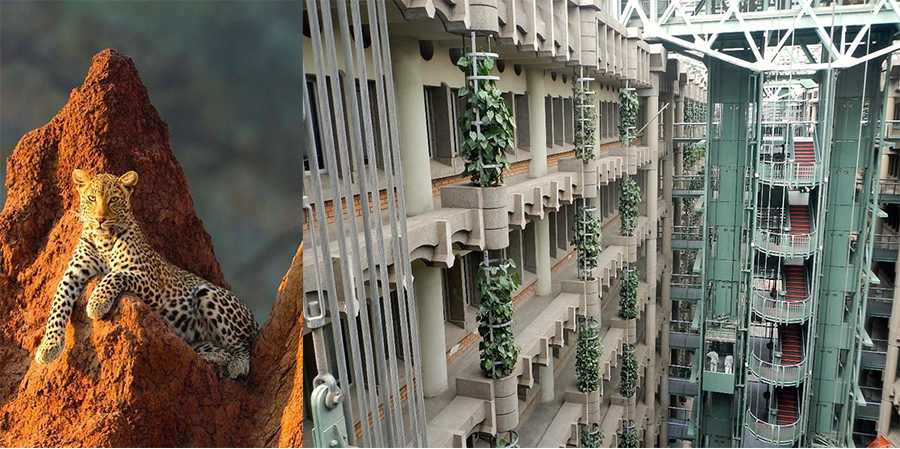
Above left: a leopard suns on a termite mound | Above right: the Eastgate Centre in Harare, Zimbabwe is famously modeled after the same ventilation design principles as termites’ natural electricity-free air conditioning.
Innovation: Artificial trees on steroids
Problem Solved: Deep carbonization; removing dangerous pollution on a massive scale
Nature’s Solution: Trees
Commercial Readiness: Early Commercial
While this may not constitute as straightforward biomimicry, I’m throwing it in here because scientists are begging for the world to pay attention to this bio-inspired technology. Climate experts believe this innovation has a major role to play in meeting the Paris Agreement 1.5°C target.
What if there was a way to do the work of 100,000 trees with just one?
There is a way, right now, to skim carbon dioxide straight from the air we breathe and reverse carbon pollution on a massive scale. Think emulating trees with freakish efficiency and less of a land footprint that can actually remove legacy emissions that have been lingering in the air we breathe that have been around since the industrial revolution. This proven and commercial engineered carbon dioxide removal path is called direct air capture, and although it was once pie-in-the-sky thinking, now it’s a viable and essential solution on the table.
This carbon capture technology has caught the attention of everyone from Janine Benyus and Bill Gates to the United Nations, whose special Intergovernmental Panel on Climate Change report released last fall says every year we wait to deploy the innovation the more we rely on it.
We’ve missed the window to simply reduce our emissions by turning to renewable energy like wind and solar. We’ve missed the window to simply depend on nature’s phenomenal carbon sinks like the ocean, forests and transforming depleted agricultural soils into powerhouse carbon storehouses. Life as we know it, or an even brighter one, depends on aggressively removing emissions as well—the report claims 100 to 1000 billion tons of carbon dioxide this century. For context, 1 billion tons is twice the weight of all human beings on Earth right now.
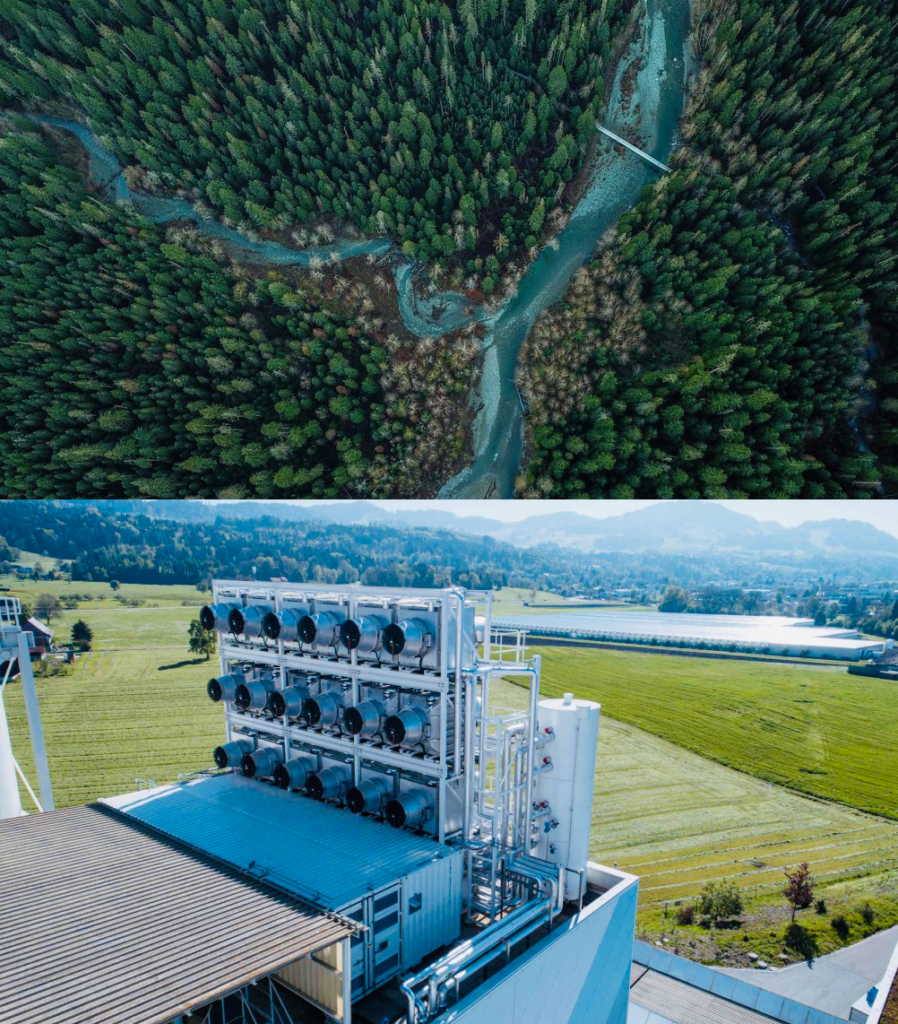
Above, trees have skimmed the air we breathe for carbon dioxide for millions of years with renewable solar power. Now engineers are looking to beat nature at its own game by emulating trees with “direct air capture” machines that mine the sky of carbon dioxide to avoid the risks linked to C02 levels that have reached their highest in 3 million years. These machines exist and are proven in the real world. Below: Climeworks’ commercial direct air capture machine in Switzerland repurposes carbon dioxide to help grow crops in greenhouses.
Can we just plant more trees?
As I write this, the Amazon, Siberia, and Indonesia burn. It is impossible not to acknowledge our planet’s lungs are filling with smoke and cranking up the carbon dioxide, the world’s ultimate carbon sinks collapsing to ash on our watch. Especially gut-wrenching when many would argue if we want a proven, economical solution, then planting trees (and less obvious forests like mangroves and underwater kelp) are our greatest hope. They’ve been successfully sucking carbon dioxide out of the air for millions of years, and it would do all life on Earth good if we plant more forests, stop chopping them down, stop setting forests on fire and actively rewild our lands. But that’s not enough. Science also shows with nearly eight billion people and less land with rising seas and forests chopped down for farms and pastures, we don’t have the space or time to offset our carbon emissions with trees alone. We can’t wait five decades for trees to do their thing. We need both nature and engineered technologies at massive scales.
How do the carbon removal machines work?
Direct air capture machines use low-carbon energy to suck carbon from the air we breathe with fans and filters, then catch the carbon dioxide. Once captured, carbon dioxide can be buried underground (putting the C02 back where it came from) or repurposed in a potentially trillion dollar market in applications like concrete, carbonated beverages, low-carbon fuels, fertilizer and biodegradable plastic. Beyond the potential economic benefits, repurposing waste carbon as a feedstock comes along with tremendous climate benefits.
Why are they dubbed the ugly duckling of climate solutions?
Carbon capture technology has controversial ties to fossil fuel companies. Enhanced oil recovery (EOR), essentially injecting carbon dioxide into aging oil fields to release stubborn pockets of oil, is currently captured carbon dioxide’s largest market. Even still, carbon capture technology is now regarded by leading scientists as a key part of reversing the climate change puzzle, and increasing climate experts believe repurposing carbon dioxide from anthropogenic sources is a bridge solution—not ideal, but a step forward—even if it’s a bit of a puzzling market for the technology.
What’s next for this potentially life-changing technology?
Direct air capture machines have their challenges. They are in the early stages, very expensive, they need massive scale ups, and while they can be located almost anywhere, these carbon removal machines require access to low-carbon energy/renewables and water, not to mention there is not a real market for carbon dioxide removal right now. But they are improving every day, the technology keeps getting better, and they are gaining traction as a tremendous tool to rebalance our planet’s systems if deployed at scale. Leaders in the space are Climeworks in Switzerland, Carbon Engineering in Canada and Global Thermostat in the USA.
Right now this negative emissions technology captures trivial amounts, but just like wind and solar (both of which are now cheaper than coal in the USA), a fighting chance for a cleaner future has a lot more to do with politics than technological limitations.These machines are proven in the real world. The technology is already here. It’s up to us and our governments to build these machines at a magnitude that can not only change our lives and our childrens’ lives, but could change the entire planet.
Bottomline: Biomimicry is transforming how we live
Nature’s laboratory is drawing the most significant inventors of our time. That’s why biomimicry gives me hope. No matter what motivates you, there has never been a more vital time to pay attention to the innovations reframing what’s possible. Our lives and those that inherit the planet from us, and inheriting a failed climate report card they had no part in, depend on it. With biomimicry—a field that touches science, architecture, design, technology, even communication—we have a roadmap to real life solutions that can transform life on Earth at a time we need them the most. Oddly slugs, like the one who found me, may increasingly rub elbows with savvy corporations and governments if we want to innovate our way out of this mess we’ve gotten into—much messier than a little slug slime.
 Katie Losey works at the intersection of business and conservation. She is a director at Fragile Earth, a company focused on catalyzing a new energy era to benefit all life on Earth. Previously Katie worked for a decade at a travel company connecting others with the world’s wild places in an effort to protect and champion them, landing her with orangutans and pygmy elephants in Borneo’s ancient rainforest, gliding alongside sharks in Cuba, and tracking gorillas in Rwanda—mind-expanding experiences to explore the genius of biomimicry! She has been a member of The Explorers Club since 2015 and is currently pursuing her Biomimicry Graduate Certificate to help communicate, scale, and deploy life-changing innovations. Katie lives in NYC’s West Village with her irresistible spotted rescue dog, Nelle.
Katie Losey works at the intersection of business and conservation. She is a director at Fragile Earth, a company focused on catalyzing a new energy era to benefit all life on Earth. Previously Katie worked for a decade at a travel company connecting others with the world’s wild places in an effort to protect and champion them, landing her with orangutans and pygmy elephants in Borneo’s ancient rainforest, gliding alongside sharks in Cuba, and tracking gorillas in Rwanda—mind-expanding experiences to explore the genius of biomimicry! She has been a member of The Explorers Club since 2015 and is currently pursuing her Biomimicry Graduate Certificate to help communicate, scale, and deploy life-changing innovations. Katie lives in NYC’s West Village with her irresistible spotted rescue dog, Nelle.

